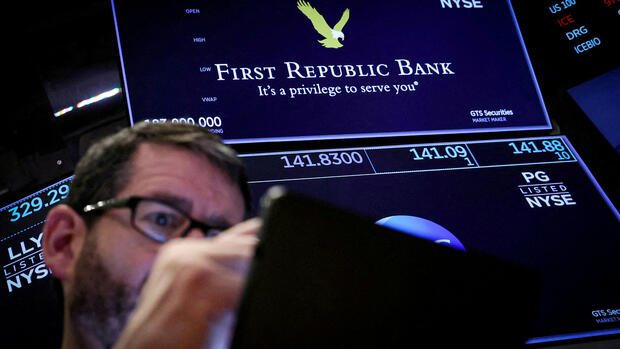Denver Regional bank First Republic is battling a loss of customer and investor confidence. The stock fell 50 percent on Tuesday. Concerns about the bank’s stability have returned after poor quarterly figures released by the San Francisco-based bank on Monday.
The institute is apparently considering divesting assets worth between $50 billion and $100 billion, according to the Bloomberg news agency. It is said to be primarily mortgages and securities with long maturities, of which the First Republic holds a higher proportion on its balance sheets than other institutions.
The California bank, which has total assets of $233 billion, had focused on wealthy customers and was known for providing them with large mortgages on favorable terms. In the United States, home loans are often given at fixed interest rates and with a term of 30 years. However, these mortgages have lost significant value as a result of the recently significant increase in key interest rates set by the central bank, the Fed.
Loans to deposits are out of balance after a bank run in March, analysts warn. Customers had withdrawn a good $100 billion from the First Republic last month after the Silicon Valley Bank (SVB) went bankrupt, the bank announced on Monday evening. That was more than analysts had expected. However, the outflows have largely subsided, according to CEO Michael Roffler.
Ditching the assets could then pave the way for a capital raise, according to Bloomberg. Regulators are currently discussing what a new bailout package could look like with other major banks. It is conceivable that other institutions will buy the First Republic’s assets at a price that is higher than the current market value. In exchange, they could receive warrants or preferred stock of the First Republic.
turbulence due to high interest rates
It is still unclear whether other banks would be willing to do this. Eleven major financial houses parked $30 billion in deposits with the First Republic in March to stabilize the institution and send a signal of confidence. America’s largest bank, JP Morgan Chase, Bank of America, Citigroup and other big money houses have presented solid figures for the first quarter. But they, too, are preparing for turbulence and have increased their risk provisions for loans at risk of default. It is unlikely that a buyer can be found for the First Republic.
After the collapse of SVB and New York’s Signature Bank, the Fed launched a new lending program to support regional banks. There, the institutions can deposit bonds at par as collateral and receive loans to strengthen their liquidity. First Republic also made use of it, as the institute announced on Monday. In the medium term, however, this could bring the bank into additional difficulties, analysts warn.
The bank pays interest on loans from the Fed and other programs of three to five percent. However, the bank receives lower interest rates for the loans, which the bank largely granted during the low-interest phase before the interest rate turnaround, which endangers the business model. The stock has lost 93 percent of its value since the beginning of the year.
Overall, banks now have to offer their savers higher interest rates in times of higher interest rates. Money market funds attract investors with returns of four to five percent and have recently recorded record inflows. The First Republic, like many others, is losing a cheap source of funding that was once a cornerstone of its business model.
Other regional banks have stabilized again after the SVB bankruptcy and the general market uncertainty. Los Angeles-based Pacwest even reported rising deposits again on Tuesday evening. The stock then rose a good 16 percent in after-hours trading.
More: Dwindling deposits and competitive pressure: The SVB is facing a difficult new start
